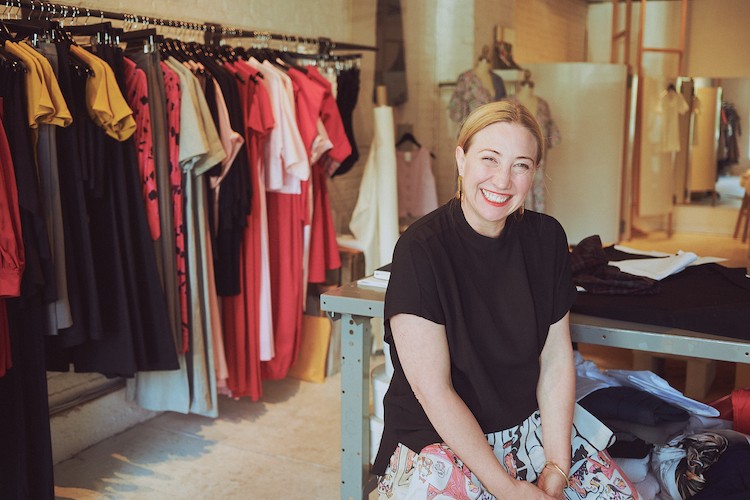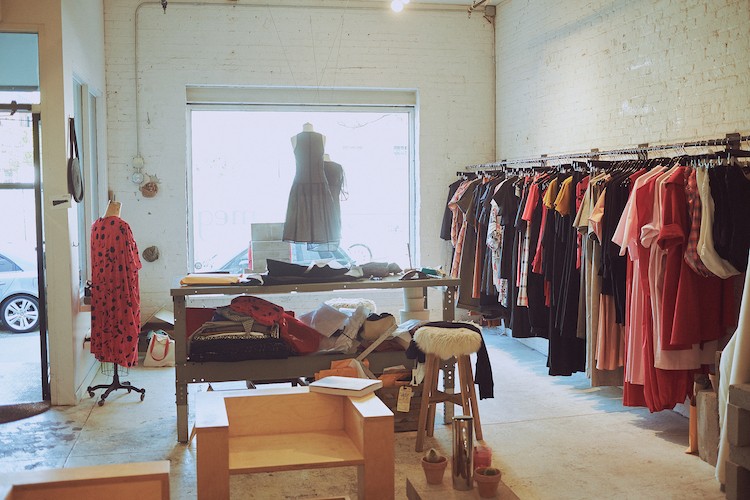Meghan Kinney fell into the world of sustainable fashion by accident. When she started out, she had no idea that keeping her supply chain close and reclaiming fabric was beneficial to the environment. To Meg, the way to be sustainable with clothing is simple: don’t buy shit.
When Meghan Kinney started her career in fashion design, she was a 22-year-old recent graduate living out of the back of her dress shop in the East Village. This was 1994, a totally different fashion landscape than we know today. Topics like sustainability and recycled fashion weren’t the center of attention as they are now. Meg’s choices to use reclaimed fabric and keep her supply chain local were just crafty moves from a young, resourceful designer. In a post-Stella McCartney world, we know that Meg’s moves are two of the most important in eco-fashion, but she had just been doing what she felt was right for her brand. So when Meg says that she fell into sustainability by happenstance, she truly means it.
“I didn’t realize that [what I was doing] was a thing that someone would actually call ‘sustainable’ until much later,” Meg says. “The fact that I do everything locally and manufacture in small lots, and I also use reclaimed fabric, I didn’t know that was something sustainable until the last five years.”
Despite having been a sustainable designer for the last 23 years, Meg only actively got into eco-fashion less than a year ago. The Brooklyn-based designer was influenced by the hurricanes and other natural disasters plaguing various parts of North America in September 2017 and felt that with all of the natural problems in the world, she needed to make an effort to make a difference. “For me as a company, and a brand and as a grown-up, it’s just about being really active in attempting to be useful,” Meg explains. “I wrote this random manifesto that I sent out to my mailing list that spoke of the initiatives that I’m going to start taking to really own sustainability as something I’m going focus on growing. Since then, we’ve started to look at different people who we buy fabric from, we are much more conscious about trying to use more reclaimed goods than we were in the past.”
Having spent her entire career ethically, putting the label of “sustainable” on her brand doesn’t change much. And now that she’s fully immersed herself in the world of eco-fashion, Meg has a lot to say on the topic. “I think what is really important is this ongoing conversation is in the textile resources,” she says. “I create some of my own fabric, I source for reclaimed goods out of different mills.” What is noticeable since the “sustainable” stamp of approval has reached her brand is that the designer’s inventive, whimsical style has tumbled into creative solutions to issues of sustainability. Meg tells, “For us one of the initiatives is trying to have people preorder the collections so that way we don’t create waste because we only make what people are ordering.”


Fashion has been deemed anywhere from the second to the ninth most wasteful industry, but regardless of what the number truly is, the fact is that the fashion industry is incredibly wasteful. Meg’s latest initiative to reduce this waste is bespoke alterations to her old designs. She encourages shoppers to bring their past purchases back to the boutique, where she tweaks, revamps, and gives new life to the clothing. “Just to try to find another life of it versus throwing it away,” she explains. “I had one woman who had burnt her dress, she literally has this huge hole on her dress, so now we’re doing this weird dot pattern around it, just to you know, make it into something new. Like old to new, without necessarily starting afresh.”
Also on Meg’s agenda is a clothing swap, for customers who no longer want the style and don’t want to try a revamp. “During cocktails and try-on parties, everybody takes each other clothes home. And it is super fun. And I get to see my archive, because I don’t keep anything, so for me, that’s amazing.”
While Meg’s garment revival and clothing swap might not stop fashion waste on a global level, any step to reduce discarded clothing makes an impact. The fashion industry’s problem with waste stems from abandoned items—consumers giving up on a piece of clothing in favor of the latest, newest, freshest trends.
“I think trends have been over forever,” Meg says. “I feel like there was time when trends had importance, but now I think people care about individuality and that is completely contradictory to trends.” Meg sees personal style as the answer to sustainability. Following fads or buying poorly made fast-fashion items just adds to the waste problem in this industry; trend pieces are the first to go when we discard clothing.
“You know what you are, what your personal style is, so don’t buy shit,” Meg says. “What you are going to purchase is going to reflect you forever.”
Meg believes that the fashion industry will become fully sustainable eventually. “I think we’re gonna get there over time,” she says. “The consumer will drive it, and the consumer now is definitely interested in transparency.”